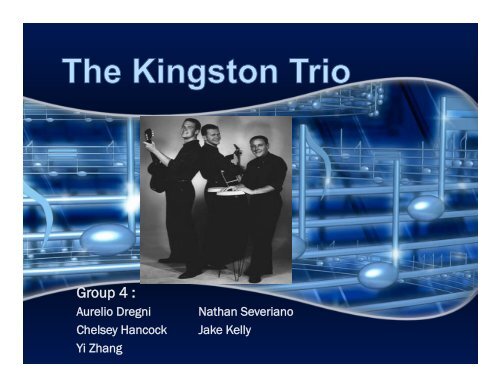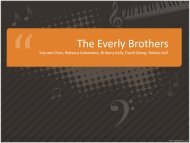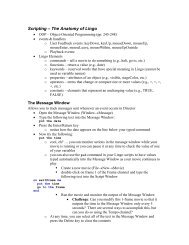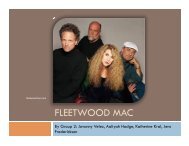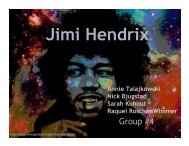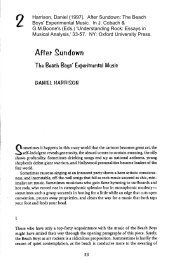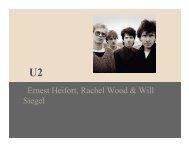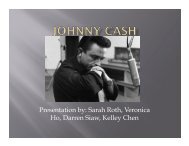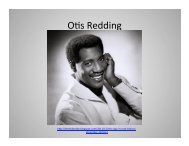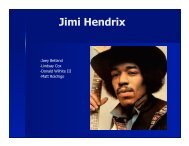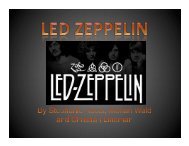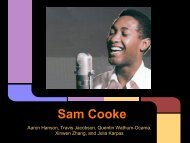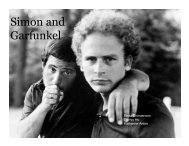group 4 - everly brothers.pptx (Read-Only)
group 4 - everly brothers.pptx (Read-Only)
group 4 - everly brothers.pptx (Read-Only)
- No tags were found...
Create successful ePaper yourself
Turn your PDF publications into a flip-book with our unique Google optimized e-Paper software.
Group 4 :Aurelio DregniChelsey HancockYi ZhangNathan SeverianoJake Kelly
The Kingston Trio is one of biggest American folk and popmusic <strong>group</strong> started in San Francisco in late 1950s.The <strong>group</strong>'s success and influence transcended its actual sales.They built up for folk music.Hit AlbumsReleased: June 1958Hit recording : Tom DooleySold over 3 millionReleased: January 1959Released: October 1960Released: June 1964
The <strong>group</strong> was founded in Palo Alto, CA, by Dave Guard(1934-1991),a graduate student from Stanford University, and two of his close friends,Bob Shane (born 1934) and Nick Reynolds (1933-2008), from Menlo College1957, Voyle Gilmore, Capitol Records producer, saw them play at the Purple Onion (a leading night spot in San Francisco) then signed a seven-year contract with Trio.1958, from their first album, picked by a DJ in Lake salt city who beganplaying it, become a single in July of 1958—it spent October through January in theBillboard Top Ten, selling over three million.In the late 50s, the Kingston Trio immensely popularwith almost every segment of the mass audience,most of all among college students, who were attractedin their mix of folk songs, humor, and goodspirits.
1961, The Kingston Trio faces their first major crisis . Because of growing differencesover the musical direction of the <strong>group</strong>, Dave Guard left.Guard was the one who knew a lot of the folk songs, especially the songs from othercountries, that the Trio had performed and recorded. However, the new memberJohn Stewart joined them at the same year.1962, there was a split in the folk music audience and community. With the collegeaudience gone, all that the Trio could find as listeners were the folkies.1963, their sales plummeted , and the arrival of the Beatles and the British Invasionin early 1964 sealed their fate.In June 17 , Trio's farewell gig was held at the Hungry I in San Francisco.
The Kingston Trio made use of the musicalability they already had. They knew how to singharmonies together, and they each knew howto play a string instrument: Dave Guard playedbanjo, Bob Shane played guitar, and NickReynolds played guitar with his experienceplaying ukelele.They pioneered folk music, with ideas fromHarry Belefonte's Calypso work.They also developed a stage presence similarto a comedy routine, with comical banter usingcharacters based on their own personalities.
• The Kingston Trio were one of the first folk <strong>group</strong>s thatbecame widely popular. They are cited for starting theurban folk revival, developing folk-rock, and bringing tocollege students.• Their occasional use of political lyrics also paved the wayfor the political protest songs of the 60's.• For instance, their song "Where have all the flowersgone?" was their first overtly political piece. It resonatedwell with youth just as the antiwar movement wasbegining, around the time of the Cuban Missile Crisis.• Artists like Peter, Paul, and Mary, and Bob Dylan usedthis momentum as they moved into more political anddeeper songs.
The Trio's instrument lineup of 2 guitars and a banjo isreminiscent of C&W <strong>group</strong>s of the 50s, but NickReynolds' playing of his guitar like he learned theUkelele created a new sound that contributed to theguitar playing of the future.They also created an audience for folk music. Beforethem, few would pay to listen to a few college studentsplaying guitar and banjo and singing harmonies of folkmusic. This was reserved for C&W audiences beforethem.Finally, without the Kingston Trio, record companieswould not have enev considered unknown artists likeBob Dylan, the Weaver's Pete Seegar, or Peter, Paul,and Mary.
• The Kingston Trio made their rise in a time when Rock & Rollwas on the rise, and folk music was just breaking out of aslump.• Each original member of the <strong>group</strong> had different musicalinfluences, in particular;--Dave Guard and Bob Shane were particularly influenced byHawaiian music with soft guitar and ukulele.--Nick Reynolds was also inspired by worldly instruments,having learned the ukulele and Bongos at a young age.--Later member, John Stewart, was inspired by artists likeBuddy Holly and Elvis Presley.
• The Weavers may be the largest individualinfluence on the formation of the Kingston Trio.• The <strong>group</strong> was formed in 1948 and waspopular through the early 1950’s.• They were a folk music quartet, that also sangblues, gospel, and children's music.• Their style inspired the commercial “folk boom”of the 1950’s.
• Music Historian Richie Unterberger says theimpat of the Trio made acoustic folk rockcommercially viable, and paved the way forsinger-songwriter, folk rock, and Americanaartists.• The banjo/ guitar combination had animmediate impact on the <strong>group</strong> Peter, Paul, andMary, who use the same fundamental folkconcept.
• The influence of the Trio goes far beyond theearly folk music years.• Lindsay Buckingham of Fleetwood Mac, AlJardine of the Beach Boys, Jefferson Airplane,Jimmy Buffet, and even pop <strong>group</strong>s ABBA andthe Bee Gees have all cited the Kingston Trio asinfluences.• The late 50’s revival of folk music also helpedlead to Bob Dylan, Joan Baez, and The Byrdscoming about in the 60’s.
• American folk music quartet in theGreenwich Village area of New York city.• Pete Seeger, Ronnie Gilbert, Lee Hayes,and Fred Hellerman.• Musical influences were blues, gospel,children’s songs, labor songs, andballads.• String-band style inspired the commercialentity of the “folk boom” that followedthem including The Kingston Trio andPeter, Paul, and Mary folk bands.
• Four Years strong with over 4 million inrecord sales• Hays and Seeger worked on peacecampaigns and demonstrations forhuman rights, civil rights, and workers’rights during WWII• During the 1950’s ‘Red Scare’, theband had affiliation with theCommunist Party, they testified, buttheir popularity became meager andthey disbanded.
• The Rolling Stone Encyclopedia of Rock and Roll calledPeter, Paul and Mary "the most popular acoustic folkmusic <strong>group</strong> of the 1960's.”• They were quoted saying, “We were very much TheWeaver’s children.”• Peter Yarrow, Noel Paul Stookey, and Mary Travers madetheir debut in 1961 at the Bitter End in GreenwichVillage. On the strength of this performance, they weresigned to a recording contract with Warner Brothers.• During that decade, they produced 11 albums, 5 ofwhich became million sellers. And they scored 12 hitsingles, including the classic children's song, "Puff, theMagic Dragon" and "Leaving on a Jet Plane," a balladwritten by John Denver.• The <strong>group</strong> brought folk music to a new prominence inthe post-McCarthy era, putting songs about politics andmorality on the radio amid the syrupy boy-girl love songsthat dominated when they began playing together in theearly 1960s.
• Released in May 1962, their first titled albumincluded their rendition of Pete Seeger's song, "IfI Had a Hammer," a hit that was the first recordto bring protest music to a mainstreamaudience.• 1963, their version of "Blowin' in the Wind"became a hit, and the first commerciallysuccessful recording of a song written by BobDylan.• As their fame grew, Peter, Paul and Mary mixedmusic with political and social activism. In 1963the trio marched with the Rev. Dr. Martin LutherKing Jr. in Selma, Alabama and Washington, D.C.• The three participated in countlessdemonstrations against the war in Vietnam. Andthey sang at the 1969 March on Washington ofwhich Peter helped organize.
• Folk Songs and Blues• Hit Album The Freewheelin’ Bob Dylan (1963)contained original material and gainedattention of the Folk community.• Emerged as a major star of the folk movementin 1964 when he released, The Times They Area-Changin’.• Acoustic guitar and harmonica• Used dry wit and sarcasm in his lyrics• Became known first in MPLS Dinky Town areawith Woody Guthrie(he attended the U of MN,very short lived), and followed Guthrie out toNew York, The Greenwich Village.
• A new style of music was born, folkrock, with electric guitar in 1965 (alongside The Byrds).• “Like a Rolling Stone” (1965) and newalbum, Blonde on Blonde (1966)combined the two rock and folk styles;it was rock’s first double album.• His lyrics brought symbolism, internalironies, thought provoking messages,dry wit and sarcasm, surrealism andgraceful flow. They were the mostsophisticated since the beginning ofRock and Roll, (Stuessy and Lipscomb).
• While most of the Kinston Trio’s musical influences came alongearlier in their lifetimes from their upbringings, the political andsocial events that took place during their musical era had a greatimpact on some of their later music.• Two important social and political movements that affected thecountry and the music of the Kinston Trio was the precursor to theAnti-War Movement of the early 1960-75, as well as the CivilRights Movement of 1955-65.
• Although the Vietnam War, along with the huge anti war protests,didn’t take place till 1965, the social and political atmosphere ofthe youth during the early 1960’s was becoming charged.• With the Kingston’s Trio cover of “Where Have All the FlowersGone,” their apolitical position had transitioned to an antiwarposition.• The songs lyrics speak about the disappearance of the country’smen leaving for the army and how they return dead to theirgraves.• Excerpt of the lyrics:Where have all the soldiers gone? Long time passing. Where have all thesoldiers gone? Long time ago.Where have all the soldiers gone? Gone to graveyards, ev’ry one. Will theyever learn? Will they ever learn?
• The Civil Rights Movement was at peak during the years of1955-1965, with landmark events including, the Montgomery BusBoycotts (1955-56), Freedom Rides of 1961, the March onWashington of 1963, Civil Rights act of 1964, as well as theVoting Rights Act of 1965.• It was in 1963 when the Kingston Trio released their recording of“Road to Freedom,” Which expressed the hopes and ambitions ofthe blossoming civil rights movements.• Excerpt from the lyrics:And we’re comin’ one by one. You didn’t see us two by two. Ev’ry time youturn around another’s comin’ through. So we’ll sing it long and proud soev’ryone will know that the road to freedom is a long, long way to go.
1. Allan Shaw, the Kingston Trio,http://www.folkera.com/ktrio/bio.html2. Eder, B., (2012). The Kingston Trio.http://www.allmusic.com/artist/the-kingston-trio-p2038/biography3. Rolling Stones. Peter, Paul and Mary discography.http://www.rollingstone.com/artists/peterpaulandmary/discography.4. Ruehl, Kim. The Weavers. http://folkmusic.about.com/od/artistsaz/p/TheWeavers.htm.5. Stuessy, J., and Lipscomb, S.D. (2013). Rock and roll: Its history and stylisticdevelopment, 7th edition. New York, NY: Pearson. ISBN: 978-0-205-24697-7.6. The New York Times. Peter, Paul and Mary Return in Concert of Peace and Protest.1970.http://select.nytimes.com/gst/abstract.html?res=F00C15FE3B5C1B7493C2A81783D85F448785F9.7. Eder, B. (n.d.). The kingston trio: Biography. Retrieved fromhttp://www.allmusic.com/artist/p2038/biography8. Cozzens, L. (1998, June 22). The civil rights movement 1955-1965.Retrieved from http://www.watson.org/~lisa/blackhistory/civilrights-55-65/index.html9. Barringer, M., & Wells, T. (1999, June 22). The anti war movement inthe united states. Retrieved fromhttp://www.english.illinois.edu/maps/vietnam/antiwar.html


